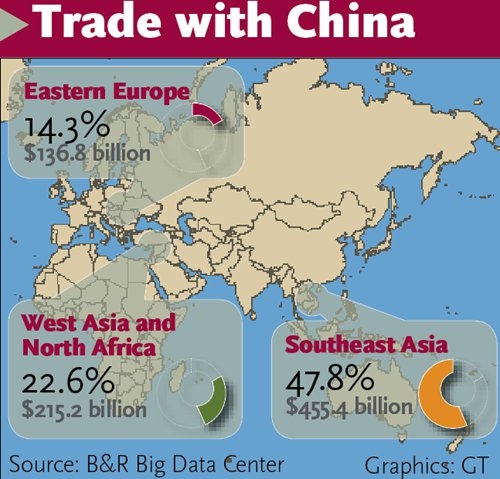Belt and Road
Your Present Location: PROGRAMS> Belt and RoadB&R to boost global trade
Source: Global Times Published: 2017-5-8
China`s One Belt and One Road initiative has brought the country`s experience in industrialization and urbanization to many countries around the world, becoming a new engine of global economic development, experts said.
According to the latest data from the Belt and Road big data center under the State Information Center, China and countries along the Belt and Road initiative already create about one-third of global trade volume.
China`s trade with Southeast Asia accounted for the biggest share along the Belt and Road routes in 2016, reaching $455.4 billion, or 47.8 percent of China`s trade with the Belt and Road countries.
"Before the Belt and Road initiative, we had the China-ASEAN Free Trade Area. The Belt and Road is not just about trade but also involves investment and infrastructure development. This guarantees sustainable growth in the future," said Xu Liping, a research fellow at the National Institute of International Strategy under the Chinese Academy of Social Sciences.

Benefit the locals
In recent years, due to structural problems, the growth of China-Southeast Asia trade has been slow, Xu said. For instance, many clothing manufacturers moved to Vietnam because of lower labor costs. However, Vietnam still needs to import auxiliary materials from China, so profits for Vietnamese companies are not so high and China still maintains a trade surplus with Vietnam, Xu said.
The Belt and Road initiative will help balance trade, experts said. "Under the Belt and Road initiative, investment and infrastructure development is increasing in Vietnam, which will help China`s auxiliary material producers to move to Vietnam, and provide the foundation for long-term sustainable growth," Xu said.
In 2016, China`s trade surplus with Vietnam narrowed and trade became more balanced. China`s Commercial Counselor to Vietnam Hu Suojin said Vietnam`s exports to China increased by 20.8 percent year-on-year to $32.9 billion in 2016, which means its trade deficit with China was reduced by 31 percent, the Xinhua News Agency reported.
The Belt and Road is also benefiting local people while boosting trade with China and the outside world.
Pak China International Group (Pvt) Ltd, incorporated in Pakistan in November 2016, is a company focused on seafood trading between China and the South Asian country.
The company is expected to greatly contribute to Pakistan`s seafood exports, according to Eddie Wong, CEO of Shenzhen Hezhengyuan Group, the parent company of Pak-China International Corp.
"Before we established our company, fishermen in Pakistan attempted to export Indian Ocean seafood to China via different ports, and their attempts were mostly unsuccessful. But our company, which started to ship seafood at the end of 2016 through the China-Pakistan Economic Corridor, set a sound basis for trade between the two countries," Wong told the Global Times on Sunday.
The company transported the first batch of seafood, including prawns, cuttlefish and squids, worth $26,700 to China in December 2016, and plans to ship seafood worth more than $150,000 by the end of May.
Pak-China International Corp has now hired eight local employees and aims to create more jobs for the country with the expansion of its business, Wong said.
"We are also considering exporting lower-cost products like small home appliances from Yiwu, [in Zhejiang Province] through our subsidiary in the Xinjiang Uyghur Autonomous Region," Wong said.
For some developing countries, the top priority is infrastructure development, where China boasts experience, said Wang Yiwei, senior research fellow at the Chongyang Institute for Financial Studies of the Renmin University of China.
A China-funded railway linking Kenya`s capital Nairobi and the key port of Mombasa is expected to provide faster and safer passenger and cargo transportation, facilitate the country`s economic development and cement its position as an economic leader in East Africa.
Higher GDP
The project is forecast to boost the GDP of Kenya by 1.5 percent during construction, while logistics costs will be reduced by 40 percent after completion, according to a document sent to the Global Times by the China Communications Construction Co (CCCC).
Wang said "the Mombasa-Nairobi railway and Mombasa Port projects follow China`s norms and experience in construction and management.
The railway will start its trial run on May 31, an executive at CCCC said in April. The 480-kilometer railway will have the capacity of 25 million tons of cargo a year and runs at 120 kilometers per hour.
The company has always attached importance to local employee management, with more than 40,000 jobs created for Kenya so far, it said. CCCC also trains people in railway technologies in Kenya by establishing training bases and setting up railway engineering courses in universities.
Key Words: Belt and Road; railway; trade























































































 京公网安备 11010802037854号
京公网安备 11010802037854号





